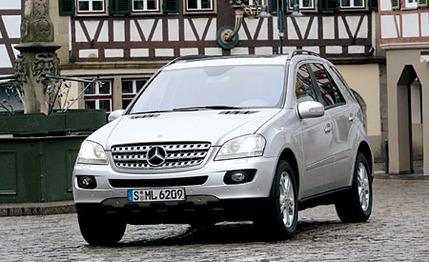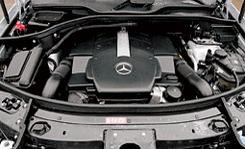
 First Drive Review
First Drive Review
In 1997, Mercedes-Benz's new ML320 SUV, which was built in Tuscaloosa, Alabama, largely for the American market, met with great acceptance from the majority of SUV fans. They were delighted by this sport-ute that not only wore the prestigious three-pointed star but also came to market with the remarkably low base price--for a Mercedes--of $34,545. Although critics were soon carping that its all-wheel-drive system was not up to dealing with heavy-duty off-road assignments and its interior appointments were low-rent, the M-class was a success, with almost 300,000 of a 570,000-unit production run sold in the U.S. Although it has been gradually upgraded over its lifespan, the first-generation M-class isn't competitive with the host of luxury SUVs now available.
The 2006 M-class is no longer a stubby, high-riding box on wheels. This new version is a much more graceful truck with longer and wider proportions, a flowing roofline, and prominent wheel housings. Length is up 5.9 inches to 188.5 inches. Width has grown 2.8 inches to 75.2 inches. These changes, combined with a height reduction of 0.4 inch, give the M-class a vastly sleeker profile than its predecessor. A 3.7-inch wheelbase increase matches these new proportions and provides an additional 1.4 inches of rear-seat knee room. The available third-row seat has been dropped because Mercedes says no one wanted it in the old model.
In addition to its high-style sheetmetal, the M-class has an all-new structure. In place of the first version's separate ladder-type frame, the '06
M-class has a unibody like every other Mercedes model. This new chassis is stiffer and about 80 pounds lighter. It also has front and rear crumple zones that provide more gradual energy absorption in a collision. As in the first version, all M-classes come with four-wheel drive, but the two-speed transfer case is no longer standard equipment--it's optional. Also optional are lockable center and rear differentials. The base setup makes do with three open differentials (center, front, and rear) and a traction-control system that shifts the torque to the wheels with grip. The M-class also has an off-road button on the center console that optimizes the anti-lock brakes and traction control for off-road conditions.
Anyone willing to take his or her M-class on the Rubicon Trail is going to want the optional air suspension that, at the flick of a switch, raises the body and increases ground clearance to a maximum of 11.5 inches.

 Two models will grace our shores. The ML350 gets its power from a new 268-hp, 3.5-liter V-6 with four-valve heads. The ML500 gets the torquey 302-hp, 5.0-liter 24-valve V-8. With 339 pound-feet of torque between 2700 and 4750 rpm, the ML500 is smooth and energetic and should be capable of accelerating from 0 to 60 mph in about seven seconds. Some of the credit for this performance goes to the Mercedes seven-speed automatic transmission that is spreading throughout the Benz lineup. But a glance at the center console left us asking, "Where'd the shift lever go?" It's now located on the steering column--think 7-series BMW--and it electronically controls the 7G-Tronic gearbox. Manual shifting is accomplished via buttons that are located on the back of the steering wheel. The Stuttgart team calls this system Direct Select, and we mastered it in short order.
Two models will grace our shores. The ML350 gets its power from a new 268-hp, 3.5-liter V-6 with four-valve heads. The ML500 gets the torquey 302-hp, 5.0-liter 24-valve V-8. With 339 pound-feet of torque between 2700 and 4750 rpm, the ML500 is smooth and energetic and should be capable of accelerating from 0 to 60 mph in about seven seconds. Some of the credit for this performance goes to the Mercedes seven-speed automatic transmission that is spreading throughout the Benz lineup. But a glance at the center console left us asking, "Where'd the shift lever go?" It's now located on the steering column--think 7-series BMW--and it electronically controls the 7G-Tronic gearbox. Manual shifting is accomplished via buttons that are located on the back of the steering wheel. The Stuttgart team calls this system Direct Select, and we mastered it in short order.
The new M-class suspension--control arms in front and a multilink arrangement in the rear--keeps the tires in intimate contact with the road. It provides excellent body control and keeps the vehicle level, even during severe load changes. With the air suspension, the ML500 we sampled rides firmer than its predecessor, but it still leans a good deal during hard cornering. As you approach the ML500's cornering limits, it feels neutral until the stability control calls a halt to the fun. Although the ML500 handles well when pushed, it still can't quite match the steering precision of the BMW X5 through high-speed curves.
With this second-generation M-class, Mercedes has addressed the chassis and interior-finish shortcomings that troubled the original. Coupled with the improved powertrains and more sophisticated suspension options, the M-class should appeal to a wider range of luxury-SUV buyers. Its new styling is perhaps the biggest improvement, because it provides an unusually graceful appearance without sacrificing the M-class's interior utility or reasonably trim dimensions. That should enhance the model's appeal to the wealthy suburbanites who are the core of its market.